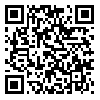BibTeX | RIS | EndNote | Medlars | ProCite | Reference Manager | RefWorks
Send citation to:
URL: http://mjiri.iums.ac.ir/article-1-2573-en.html
Background :The CCR5 is a chemokine receptor that serves as a co-receptor for HIV-1 attachment and entry to T lymphocytes. A 32bp deletion (∆32) in this gene is believed to be associated with resistance to infection and delay disease progression. The aim of this study was to determine the ∆32 allele frequency in healthy individuals and HIV-infected individuals with AIDS.
Methods : In this experiment, 530 normal individuals from healthy Iranian population and 40 HIV-infected samples from Western Clinic of Tehran were examined for ∆32 in CCR5 gene using polymerase chain reaction (PCR) techniques followed by agarose gel electrophoresis.
Results : Allele frequencies of the CCR5∆32 in normal individuals were calculated to be 1.1% for heterozygous genotype and 0.19% for homozygous genotype. None of the co-receptor gene in HIV cases was found to be mutated in this study.
Conclusion : Based on the findings of this study and the literature in Iran, we could conclude that Iranian people similar to neighbor countries such as Arabs are susceptible to HIV virus infection.
| Rights and permissions | |
 |
This work is licensed under a Creative Commons Attribution-NonCommercial 4.0 International License. |





